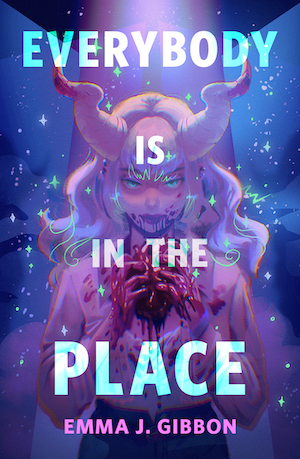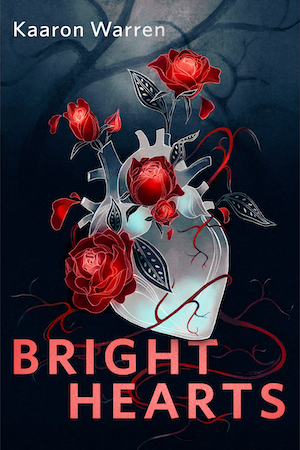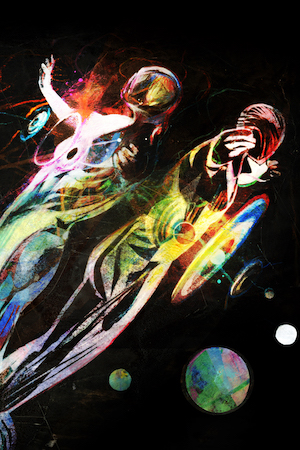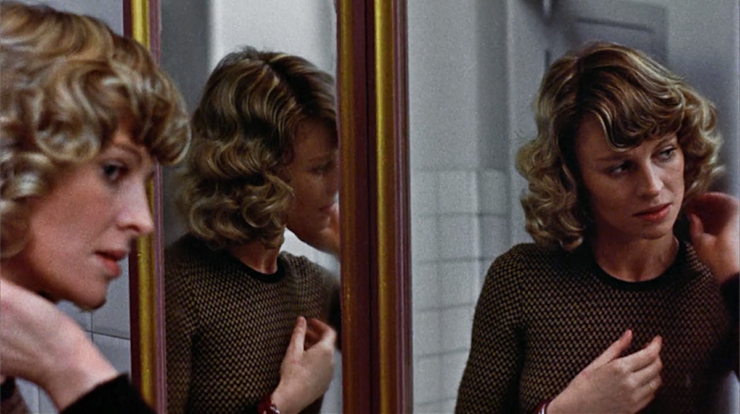Have you ever felt that life was both vastly peaceful and viciously menacing?
Don’t Look Now, first released to cinemas in 1973, embodies that paradox and about a gazillion others. In both content and legacy, the film is a mass of contradictions. It’s at once both realistic drama and supernatural horror. Beautifully photographed and conspicuously ugly. An acclaimed mainstream classic that also, somehow, feels as alluringly forbidden as an illicit grindhouse film.
Calling it a movie feels wrong. It’s more like a darkly enchanted vision that spontaneously came into existence. A message sent from a mysterious other side, somehow caught on celluloid. It’s jarring to see photos of director Nicolas Roeg on set with lead actors Donald Sutherland and Julie Christie. This amorphous thing was planned? It was the result of work? On the other hand, magic is rarely as spontaneous as we imagine. Even witch’s brew, after all, has to be brewed.
Don’t Look Now is a film essayist’s dream. It contains multiple standout elements to explore: a shocking death, a famous sex scene, another shocking death, a time-bending structure. But for all that, the movie will remain forever elusive. Trying to pin it down is an exercise in foolishness.
But let’s try anyway.
Don’t Look Now: A Beginner’s Guide
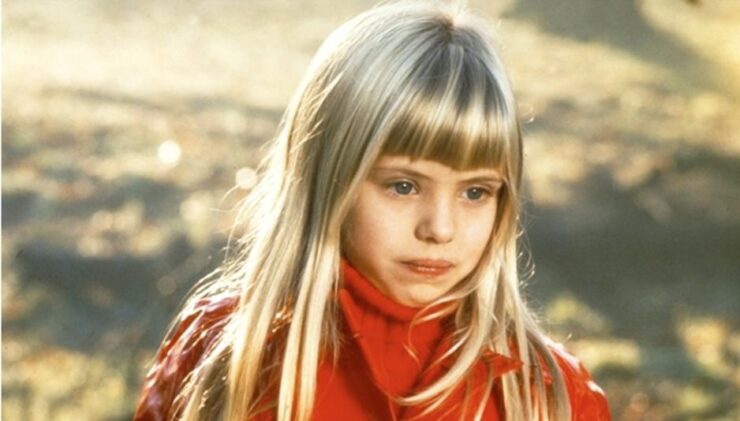
The film centers on John Baxter (Donald Sutherland) and his wife Laura (Julie Christie). After the accidental drowning of their daughter Christine, the grieving couple leave their home in England for Venice. John has been hired to restore a Catholic church. It’s the gloomy off-season. Laura befriends two elderly sisters, one of whom is blind but claims to be psychic. She says that she’s seen Christine’s spirit. This soothes Laura. In their hotel, John and Laura have passionate sex. A corpse is discovered in the canal, the latest victim of a serial killer. The psychic sister tells Laura that John is in danger and is himself psychic. John regards the sisters as kooks and berates Laura for listening to them. Laura returns to England to visit their son at boarding school while John stays in Venice. But after her departure, John inexplicably sees Laura on a canal barge with the two sisters, which makes him suspect foul play and sets into motion a tragic series of events.
No plot summary, however, can capture how awesomely weird this movie is.
Don’t Look Now, freely adapted from a short story by Daphne du Maurier, is its own brilliantly strange thing. It’s often languidly immersive, with long stretches of John and Laura in mundane motion: boating the canal, walking the streets. Drunk one night, John swears he won’t puke, then pukes, then laments puking. A brief, eerie scene of the two elderly sisters laughing has no context. Director Nicolas Roeg is a fiend for zooms, slow motion, and cross-cutting, as well as for reflective surfaces and smashing glass. It’s not exactly what you’d call a personable film. Make no mistake: Sutherland and Christie are excellent as always and eminently likable. But Roeg often strands them, and us, in confusion. Non-English dialogue isn’t subtitled. English dialogue isn’t always audible. Whereas the short story is clever yet conventional, the film adaptation is almost never not strange. And it’s drenched in hideous grief from start to finish.
If you’re getting the sense that Don’t Look Now isn’t the kind of fun horror movie to stream on a Friday night with a pizza, you’re not wrong. Although, full disclosure, I recently did exactly that, dragging my significant other Alicia into the mix as well. But that’s just me. Weird is my jam.
The weirdness is on full display in the virtuoso opening sequence. Christine, clad in a shiny red rain slicker, the first image in an ongoing red motif, plays outside on the Baxters’ vast estate. The day is overcast. Her older brother rides around on a bike. In a supremely strange touch, Christine has a pull-string army doll that spouts bullying commands. Inside the house, John studies photo slides while Laura reads and putters about. Director Nicolas Roeg continuously switches between outside and inside, often in matching cuts, such as between Christine’s reflection in a pond to a similarly shaped flame in the fireplace. In a mysterious offscreen accident, Christine gets stuck in the mucky pond. John, intuiting trouble, rushes outside, plunges into the water, and lifts her out. But he’s too late; she’s drowned. It’s a sequence that, as impressive as it is, might have some casual horror fans bailing on the film right away. It’s dreary, elliptical, upsetting.
There’s one scene, though, that I doubt anyone would bail on.
The Sex Scene
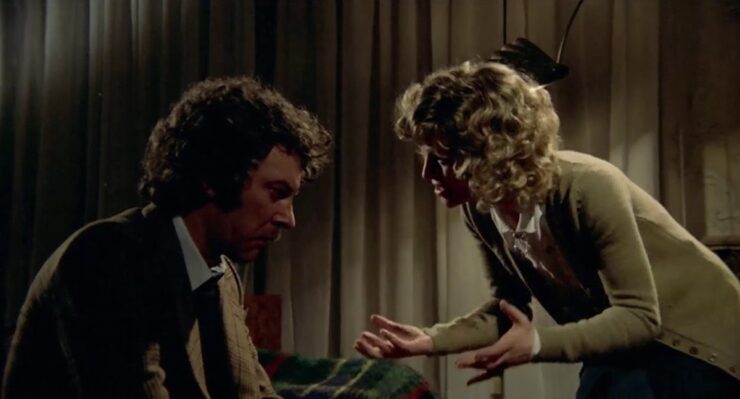
Director Nicolas Roeg had a scorching 1970s. It was his first decade as a director, following years as a cinematographer. His key ’70s films all feature sex prominently. Walkabout (1971), starring a young Jenny Agutter, centers on a teen girl and her younger brother lost in the Australian outback. A scene of Agutter skinny-dipping stirred controversy, but the film’s true sexual moment occurs when the Aboriginal boy they’ve befriended performs a mating ritual. After Don’t Look Now, Roeg directed The Man Who Fell to Earth (1976), featuring David Bowie as a space alien who becomes a wealthy, boozy, TV-obsessed recluse. The film, which utilizes and deepens the Bowie mystique, features countless sex scenes. Sincerely: I lost count. These three films, each singular, each sex-fueled, are Roeg’s most influential work. He died in 2018, but his legacy lives on. Ari Aster and Christopher Nolan, among other current directors, are huge Roeg fans.
The Don’t Look Now sex scene, based on two chaste sentences in the short story, wasn’t in the shooting script. Roeg reportedly devised the scene, very much not chaste, during filming, as a way to contrast all the scenes of the couple arguing. It was a smart decision; there’s a lot of arguing.
The scene is indeed a stunner. Roeg cuts between John and Laura together on the bed to shots of them separately dressing afterwards. The effect is heady but sad. Ecstasy, like everything else, soon passes. Out of context, the scene feels like the most inventively directed softcore porn scene ever. In context, it’s staggering. What other film contains a five-minute sex scene involving a married couple? In cinema, steamy sex is the domain of the newly in love. The steaminess here is matched by tenderness. Sutherland and Christie seem truly man and wife. A rumor that the sex was unsimulated has been thoroughly debunked—it’s just great acting, y’all! It’s perhaps the first time John and Laura have been intimate since their daughter died. In any case, it’s their last time ever. I basked in the snazzy editing as the pizza settled in my belly. Alicia, meanwhile, who was seeing the film for her second time, was trying to reconcile the realism with the supernatural.
“So, is their daughter’s ghost watching them do it?” Alicia asked.
It’s a fair question. According to the psychic sister, who we have no real reason to doubt, Christine’s spirit was sitting with John and Laura in a previous scene. But if we have no reason to doubt the psychic sister, that means big trouble for John Baxter.
Uh, 50-Year-Old Spoiler Alert?
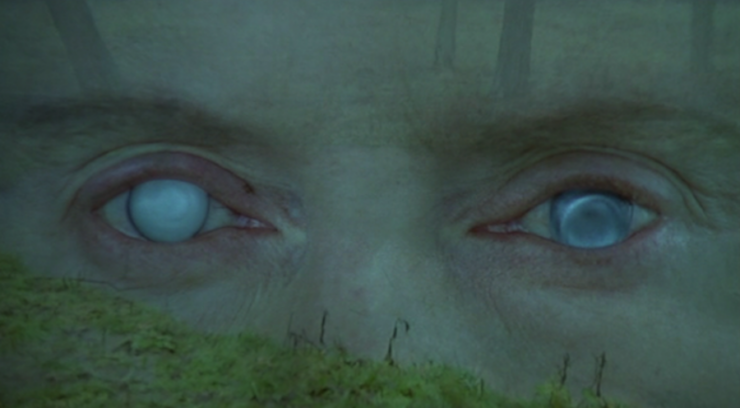
The psychic sister is correct: John Baxter, aka Donald Sutherland, is in danger. And he does have second sight. He just doesn’t realize it. The barge with his wife and the two sisters is actually a physic vision of the future—the funeral barge for his own imminent death. In the short story, the nature of the barge is a mega-sized, O. Henry-style twist ending. The movie, though, is more fluid. Daphne du Maurier deals in subjective consciousness. To a large degree, so does Nicolas Roeg, but he only represents John’s consciousness visually, in picture flashes, whereas du Maurier tells you his thoughts outright. But Roeg implies John’s second sight from the start, which du Maurier doesn’t. The result is that you could have the whole film pretty well clocked from the start or, more likely, you won’t fully grasp the story unless you watch it twice. (Even Alicia, a master of plot tracking, says she didn’t entirely get the film until her second viewing.)
Spirituality & Eternalism
There’s a moment of humor early on. Savor it, because in this great but gloom-laden movie, laughs are rarer than, say, pterodactyls. John Baxter is trying to get the distracted Catholic bishop to appreciate the magnitude of the restorations needed to the church. After the bishop departs, John turns to Laura and says, “He doesn’t give an ecclesiastical fuck about the church.”
It’s a funny line. But it leaves a sad aftertaste, because it signals another strange paradox: John Baxter, a spiritual skeptic, cares about the holy site more than the holy person does. Later, after barely surviving a scaffolding accident, John tells the bishop about the psychic sister’s warnings. The bishop rambles unhelpfully in response. He’s friendly but useless. This is in stark contrast to The Exorcist, which was released in the same year as Don’t Look Now and features priests as the saviors of health and home. Don’t Look Now isn’t anti-Catholic, but it won’t convert anyone either. The church, and in fact the entire city, looks like shit. Every other building seems on the verge of cruddy collapse. The camerawork and shot compositions are masterful but the sights are scummy. A red-lettered sign warns “Venice in Peril,” an apparent reference to the serial killer. The off-season looks freezing. Every character is buried in endless layers of coats and sweaters.
“It should be called Everyone Has a Great Cardigan,” Alicia said.
The film confirms an afterlife not through Catholicism but through the psychic sister. She accurately describes Christine’s appearance, so her psychic visions, though unseen by us, feel legit. Second sight gives Nicolas Roeg ample opportunity to explore his oft-stated belief in non-linear time—the idea that, on some level, the past, present, and future all exist simultaneously.
The concept, often referred to as eternalism, is borne out by all three of his key ’70s films. In Walkabout, Jenny Agutter’s brother glimpses ancient explorers riding along on camels, represented as a faded overlay on the present. Similarly, The Man Who Fell to Earth includes a scene where the Bowie alien and a group of pioneer settlers stare at each other from opposite sides of a rupture in time. The film is supremely indifferent to time markers. The story spans decades, but time jumps aren’t signaled; we only register them well after the fact, when we notice that the ageless Bowie alien has scored more TVs for his mammoth collection or that a supporting character’s hair has grayed. Certain scenes—those set on the alien’s home planet, for example—have no context. Is it the past? The present? The future? It often takes a moment, or several, to know. Sometimes we never know. Nicolas Roeg doesn’t give a clockwise fuck about linear time.
In Don’t Look Now, the past and future are constantly intruding on the present. There are repeated flashbacks to Christine in her red coat. The sex scene, as discussed, continuously flashes forward. But the eternalism lynchpin is John Baxter’s psychic vision of the funeral barge. In a masterstroke, Roeg stages the scene so that the barge is completely integrated into the present—just another boat passing by. There’s no cue that this is John’s subjective view. The present and future aren’t just blurred here; in this scene, at least, they’re the same damn thing.
In a way, our lives are maybe not so different. Time and memory are tricky mofos. Most of us have had a major life event that completely surprised us in the moment, but then seemed totally inevitable in retrospect. Getting dumped. Getting fired. The mind often collapses the before and after into melding, barely distinct entities, like sticky pancakes in a syrupy short stack.
Death/Rebirth
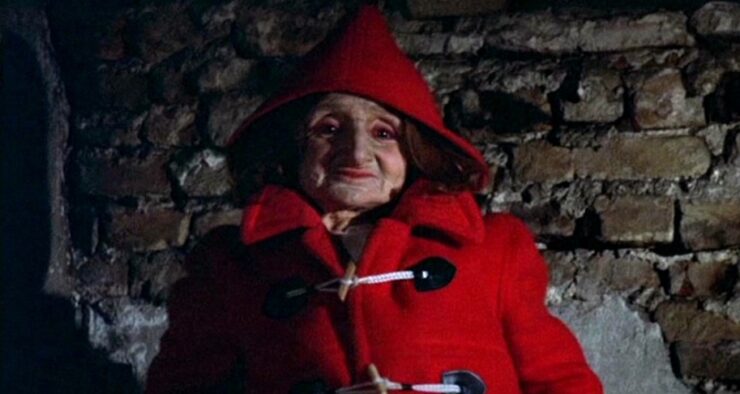
Venice, for unknown reasons, wants to be rid of John Baxter. There’s the psychic sister’s warnings, of course, and the scaffolding accident. There are also multiple scenes of annoyed locals hollering at him to get lost. In the end, Venice gets its way. On what will turn out to be his last night in Venice, and on Earth, John sees a petite feminine figure in a hooded red rain slicker. It’s not the first time he’s seen her. Has his skepticism dissolved? He seems to think it’s either Christine or a different, equally innocent child. The hooded figure flees, with John in pursuit. Laura, newly back from England, wearing red boots, races the empty streets looking for him. John chases the figure into a dark, fog-filled building. There are ominous clanks and hisses—the gears of doom are turning. John finally reaches her. She’s facing a wall, still unseen. When she turns around, it’s not a child at all. It’s an old woman, a dwarf with a cleaver. The serial killer.
John Baxter’s death is one of the grisliest, most disturbing things you’ll ever see. Fifty years haven’t dulled it at all. After the dwarf cleavers John’s throat, he collapses to the floor, gushing bright-red blood. Convulsions set in. There’s a cascade of images from previous scenes. It represents John’s recent life flashing before his eyes and also his too-late realization that he is psychic. It also represents Nicolas Roeg going awesomely hog-wild in the editing room. One shot that returns is from the film’s opening: It’s a photo slide John was studying, a picture of a church interior. The red-hooded dwarf is in a pew. Her presence in the slide, like John’s vision of the funeral barge, seems like a psychic warning from the future. And so the end loops like a tail-swallowing serpent back to the start. John raising Christine out of the pond water, another image that recurs at the end, now registers as an eerie baptism into Christine’s new life. Her afterlife.
When the movie’s over, and the pizza’s gone, questions abound. What the hell good is second sight if it doesn’t help the seer? Is the universe just messing with John Baxter? We could say that his second sight might have been helpful if only he’d comprehended it. But the psychic sister’s warnings, which at times take the form of passed-along messages from Christine, never help anyone either. Is Christine, rather than altruistically trying to save her father, selfishly leading him into death so that she has a companion in the afterlife? Why can the psychic sister, a stranger to Christine, see her spirit, while her own father cannot? These aren’t plot holes; they’re existential mysteries.
Heading to bed as the credits rolled, Alicia sleepily remarked that the music was good.
The music! The music is amazing. It’s the first film score by revered composer Pino Donaggio. The score by turns feels like a soothing lullaby and an alarming dirge. It’s beyond invaluable. Don’t Look Now is as much a mood piece as a narrative. It needs Donaggio’s evocative score the way flowers need nurturing sunshine. The movie might wither and die without it. And when Alicia, a self-proclaimed non-music person, compliments a film score, you know it’s good.
***
Don’t Look Now was a hit in its original UK release. In an all-time bummer of a double-feature, it was released as the A-film in a double bill in which The Wicker Man was the B-film. Talk about a wacky date night! Stateside, Don’t Look Now performed only decently. It was well reviewed in both countries, though few predicted its continually escalating legacy and influence. Christopher Nolan’s Memento, which dispenses with linear time almost completely, seems like a direct descendent. Ari Aster’s Midsommar, superficially a Wicker Man pastiche, closely follows Don’t Look Now’s structure of family tragedy followed by a doomed work trip to a foreign land.
The Exorcist, by contrast, was an instant horror classic. It remains deeply frightening, with a brisk, shock-a-minute pace, but for all that, the film is both conservative and reassuring. There’s a clear villain—the devil—and as hideous and green puke-spewing as he is, he can be defeated. The church can save you. Family values can prevail. Even Wicker Man, as gloriously bonkers as it is, has clear villains. No matter your spiritual beliefs, hopefully we can all agree that pagans blazing up a male Christian virgin in a fiery human sacrifice ritual is, as the saying goes, not okay.
In Don’t Look Now, a red-hooded dwarf murders John Baxter, but she’s not definitively what kills him. It’s equally true to say that his inability to grasp his second sight kills him, or that fate does. There’s cause and effect, but with eternalism in play, the cause doesn’t necessarily precede the effect. Even as the physical events lock into place, the meanings remain porous. There’s no villain, just an arbitrary instrument of death in some mysterious grand scheme. On the upside, eternalism confers a kind of immortality: John Baxter is dead, but only on one point of a timeline where all points are equal. So John and Laura Baxter are living their best day right now. But also their worst day. And their beloved Christine is at once alive, dying, and reborn as ghostly spirit.
Us too. Our lives, according to eternalism, are forever churning in time. Everything has already happened to us, is happening, will continue to happen. We’re each living our best day, and our worst day, right now. Forever. Eternally.
Mark Benedict is a graduate of the MFA Writing program at Sarah Lawrence College. You can read more of his writing at markbenedict.net,


